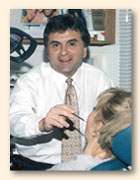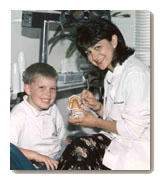Dental Articles
Dental Injuries
Trauma to the face or teeth can result from auto accidents, falls, and injury from sports such as football, hockey, soccer, volleyball, basketball, and baseball, etc. Patients suffering significant head, neck or facial trauma should be evaluated and treated in hospital emergency rooms. Such trauma may involve bleeding from the nose or ears, concussion, dizziness, lapse of memory, disorientation, severe headache and earache, or breaking (fracture) of the skull and/or jaws. Most hospitals have on their staff oral surgeons who can treat fractures of the upper or lower jaw and perform emergency tooth removal (dental extractions) and reconstruction of the dental arches.
Wear and tear of cavities and chewing hard objects such as pencils, ice cubes, nuts, and hard candies, can also lead to tooth fractures. Dental injury without associated head and neck trauma can be evaluated and treated in a dental office. Such dental injuries include broken (fractured) teeth, teeth totally knocked out of the mouth, or teeth displaced by unexpected external forces. These dental accidents may be associated with swelling of the gum and oral tissue. Cold packs or ice cubes placed either inside the mouth directly above the injured tooth, or outside on the cheeks or lips, can reduce pain and swelling before the patient reaches the dentist.
How will my injury be treated?
Chipped teeth account for the majority of all dental injuries. Dislodged or knocked-out teeth are examples of less frequent, but more severe injuries. Treatment depends on the type, location and severity of each injury. Any dental injury, even if apparently mild, requires examination by a dentist or an endodontist immediately. Sometimes, neighboring teeth suffer an additional, unnoticed injury that will only be detected by a thorough dental exam.
Types of Injuries
- An avulsed tooth is defined as when the tooth is completely knocked out of its socket. Once the tooth is knocked out of the mouth, never pick it up by the roots. It should only be picked up by the crown. The tooth should immediately be placed in a plastic container filled with whole milk, saliva or saline solution. If a container is not readily available and the athlete is conscious, coherent, can follow directions and is mature enough, the tooth can be placed under the athlete’s tongue. A tooth that has been out for over two hours has a poor chance of survival. The athlete with an avulsed tooth needs to be referred to a dentist as quickly as possible.
- A luxated tooth has been loosened but not completely knocked out. The tooth can be moved forward, backward and sideways. Treatment should consist of pushing the tooth back into its original position. The athlete should then be transported to the nearest dentist for final care.
Once the tooth has been put back in its socket, your dentist will evaluate it and will check for any other dental and facial injuries. If the tooth has not been placed back into its socket, your dentist will clean it carefully and replace it. A stabilizing splint will be placed for a few weeks. Depending on the stage of root development, your dentist or endodontist may start root canal treatment a week or two later. A medication may be placed inside the tooth followed by a permanent root canal filling at a later date.
Children between seven and 12 years old may not need root canal treatment since their teeth are still developing. For those patients, an endodontist or dentist will monitor the healing carefully and intervene immediately if any unfavorable changes appear. Therefore, multiple follow-up appointments are likely to be needed. New research indicates that stem cells present in the pulps of young people can be stimulated to complete root growth and heal the pulp following injuries or infection.
Root Fractures are common as well. There are four different classifications of fractures and are differentiated by the number of layers that are involved.
A traumatic injury to the tooth may also result in a horizontal root fracture. The location of the fracture determines the long-term health of the tooth. If the fracture is close to the root tip, the chances for success are much better. However, the closer the fracture is to the gum line, the poorer the long-term success rate. Sometimes, stabilization with a splint is required for a period of time.
Prevention
Prevention of dental injuries starts with ensuring that protective equipment is in proper working condition. In certain contact sports, mouth guards are required. In these sports they should be worn in practice as well as the game. An athlete that has orthodontia should also wear a mouth guard

 Dr. Arthur Kezian
Dr. Arthur Kezian Dr. Narine Tashjian
Dr. Narine Tashjian